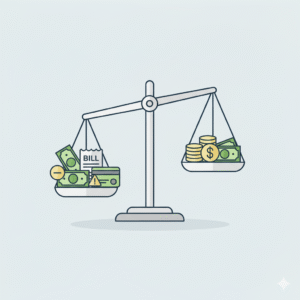Understand how to increase your credit card limit

A higher credit limit on your credit card can be a powerful financial tool. It’s not just about having more spending power; a higher limit can significantly boost your credit score, provide greater flexibility in an emergency, and unlock access to more premium card benefits. However, for many, the process of getting a credit limit increase seems like a mystery. Do you just wait for it to happen, or are there proactive steps you can take to prove your creditworthiness to your lender?
The answer is that you have more control than you think. While credit card issuers do grant automatic increases, the most effective way to raise your limit is often by asking for it—after you’ve laid the proper groundwork.
This guide will provide a complete, step-by-step strategy for successfully increasing your credit card limit. We will cover the crucial groundwork you need to lay, the different methods for making the request, how to handle a denial, and the important impact this will have on your credit score. Following these steps will maximize your chances of getting a “yes” from your bank.
Why a Higher Credit Card Limit is More Than Just Spending Power

Before we get into the “how,” let’s explore the “why.” Many people mistakenly believe that a higher limit is simply a temptation to spend more and get into debt. While that can be a risk if you lack discipline, for a responsible user, a higher credit limit offers two significant strategic advantages.
1. It Can Dramatically Improve Your Credit Score
One of the most influential factors in your credit score is your credit utilization ratio (CUR). This ratio measures how much of your available credit you are using. It accounts for about 30% of your FICO score.
- The Formula:
Your Total Credit Card Balances / Your Total Credit Card Limits = Your Credit Utilization Ratio - The Goal: Experts recommend keeping your CUR below 30%, but for the best scores, below 10% is ideal.
Now, let’s see how a limit increase helps. Imagine you have one credit card with a $2,000 limit and you typically carry a $600 balance. Your CUR is $600 / $2,000 = 30%.
If the bank increases your limit to $4,000 and your spending stays the same, your new CUR is $600 / $4,000 = 15%.
Without changing your spending habits at all, you’ve instantly cut your credit utilization in half, which can lead to a significant and immediate increase in your credit score.
2. It Provides Financial Flexibility and Emergency Support
Life is unpredictable. A major car repair, an unexpected medical bill, or a sudden need for travel can all create immediate financial strain. A higher credit limit can serve as a crucial part of your safety net, providing the breathing room you need to handle a large, unexpected expense without maxing out your card or needing to apply for an emergency loan.
Laying the Groundwork: 5 Steps to Take Before You Ask
You can’t expect your card issuer to grant you a higher limit if your financial habits are sending red flags. Before you even think about making a request, spend at least six months proving you’re a low-risk, responsible borrower.
1. Always, Always Pay Your Bills On Time
Your payment history is the single most important factor in your credit profile. A consistent record of on-time payments is the bedrock of a good credit score and is the first thing a lender will check. A single late payment can derail your chances of an increase for months. Set up autopay to ensure you never miss a due date.
2. Use Your Card Regularly and Responsibly
An unused card is unlikely to get a limit increase. You need to show the issuer that your current limit is being put to good use. Use your card for small, regular purchases throughout the month. This activity demonstrates that you are an active and engaged customer.
3. Pay Your Balance in Full Whenever Possible
While using your card is important, carrying a large balance month-to-month signals to the lender that you might be in financial distress. By paying your statement balance in full each month, you prove that you use your credit card as a convenience tool, not as a financial crutch.
4. Keep Your Credit Utilization Low
This may sound counterintuitive—don’t you need to use your limit to get it increased? Yes, but you don’t need to get close to maxing it out. The key is to show activity but keep your statement balance low. You can make multiple payments throughout the month. For instance, if you make a large purchase, you can pay it off a week later instead of waiting for your statement to arrive. This keeps your reported balance low while still showing healthy card usage.
5. Update Your Income Information
Your income is a primary factor in determining your credit limit. If you’ve recently gotten a raise, started a side hustle, or had any other increase in your annual household income, make sure your card issuer knows. Most issuers allow you to update your income directly through their website or app in just a few minutes. An outdated, lower income on file is a common and easily fixable reason for denial.
How to Ask for a Credit Limit Increase: The 3 Main Methods

Once you’ve spent several months laying the groundwork, it’s time to make the request. There are three primary ways to do this.
1. Request an Increase Online or Via Mobile App (The Easiest Method)
This is the most convenient and common method.
- Log in to your credit card account.
- Navigate to the account services or card management section.
- Look for a link that says “Request a credit line increase” or something similar.
- You will be prompted to enter your total annual income and your desired new credit limit.
- In many cases, you’ll receive an instant decision.
2. Call the Customer Service Number on Your Card
If you can’t find the option online or prefer a more personal touch, you can call your issuer directly. When you speak to a representative, be prepared to state your case clearly. Explain that you’ve been a responsible customer, have a history of on-time payments, and would like to request a higher limit. They will ask for your updated income information and process the request for you.
3. Wait for an Automatic Increase
Sometimes, if you do nothing but practice good financial habits, your issuer will automatically increase your credit limit without you asking. These are proactive reviews that banks conduct periodically for their best customers. While these are a nice surprise, they are not guaranteed. Taking a proactive approach by asking is almost always more effective.
Soft Pull vs. Hard Pull: Understanding the Credit Score Impact
When you request a limit increase, the issuer needs to check your creditworthiness. They do this by performing a credit inquiry, which can be either a “soft pull” or a “hard pull.”
- Soft Pull (No Credit Score Impact): Many major issuers, including Capital One and American Express, now use a soft credit inquiry for existing customers’ limit increase requests. This type of inquiry does not affect your credit score at all. You can request an increase without any risk to your credit.
- Hard Pull (Minor, Temporary Credit Score Impact): Some banks will perform a hard inquiry, which is the same type of inquiry that occurs when you apply for a new loan or credit card. A hard pull can temporarily dip your credit score by a few points for a few months.
How do you know which one it will be?
Often, the bank will tell you during the online request process. If you’re unsure, it’s worth calling customer service to ask, “Will this request result in a soft or hard inquiry on my credit report?” If it’s a hard pull, you may want to be more strategic about when you ask, ensuring you don’t have any major loan applications (like a mortgage) coming up in the next few months.
What to Do If Your Credit Limit Increase Request is Denied

A denial can be disappointing, but it’s also a valuable learning opportunity. By law, the credit card issuer must send you an “adverse action notice” explaining the specific reasons why your request was denied.
Common Reasons for Denial:
- Your income was too low.
- Your credit utilization on other cards was too high.
- You had a recent late payment on your record.
- You haven’t had the account open long enough (many issuers want to see at least 6-12 months of history).
- You recently opened too many other new credit accounts.
Your Action Plan After a Denial:
- Analyze the Reasons: Read the adverse action notice carefully. It will give you a clear roadmap of what you need to work on.
- Address the Issues: If your credit utilization was too high, focus on paying down your balances. If your income was the issue, wait until you have a more stable or higher income.
- Wait and Try Again: Don’t immediately re-apply. Spend another 3 to 6 months improving your financial habits based on the feedback from the denial letter, and then make the request again.
A Strategic Approach to Financial Growth
Increasing your credit card limit is a smart financial move when done for the right reasons. It’s a testament to your responsible financial behavior and a tool that can help you build an even stronger credit profile.
By patiently laying the groundwork with consistent on-time payments, responsible card usage, and up-to-date personal information, you position yourself as the ideal low-risk customer that banks are eager to reward. Whether you ask for an increase directly or earn one automatically, the result is the same: greater financial flexibility and a healthier credit score that will open doors for you for years to come.




